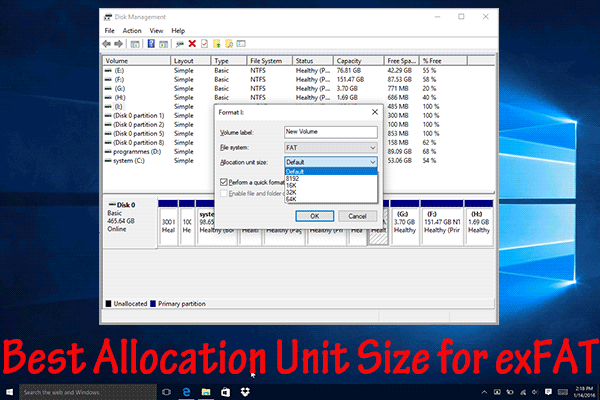
- #BEST ALLOCATION UNIT SIZE FOR EXFAT MAC AND PC FOR MAC#
- #BEST ALLOCATION UNIT SIZE FOR EXFAT MAC AND PC MAC OS#
- #BEST ALLOCATION UNIT SIZE FOR EXFAT MAC AND PC DRIVERS#
- #BEST ALLOCATION UNIT SIZE FOR EXFAT MAC AND PC UPDATE#
Besides, it's much easier to connect a drive to usb and start using it.Īs for the file format, I have a stack of NTFS hard disk. The big issue is that my house isn't wire for ethernet and the mac doesn't come with an ethernet port, so I can't test this out yet. I have some USB key but they usually have write speed slower than a hard drive. It took like 8 hours, but it appears to be working. After that I was able to copy 1.8 Tb worth of data to it.

As a test, I made a 4.5 Tb exFat volume under Veracrypt with 256K unit allocation. In addition, I don't like that the driver exists as a system extension. I haven't gotten a response from Paragon so I do not feel right using the product. I also made a mistake in my section about exfat allocation. I tried both format under veracrypt and notice that it was not significantly slower than NTFS.
#BEST ALLOCATION UNIT SIZE FOR EXFAT MAC AND PC UPDATE#
I am concern that Apple will one day push an update that locks out that functionality.
#BEST ALLOCATION UNIT SIZE FOR EXFAT MAC AND PC DRIVERS#
All of the drivers run as kernel extensions and require reduction of security on a M1 mac. I contacted Paragon, but don't have a response either. Paragon worked but it was pretty weird that it had issues with unit allocation as the drive got bigger.

The Tuxera driver plain didn't work and when I contacted them, they didn't respond.

The general recommendation is to use exFat to be compatible across windows, linux, and Mac. NTFS is faster than exfat least for copying large files. What this tells me is that exFat is significantly slower on the Mac than PC, while NTFS has essentially the same performance as PC.
#BEST ALLOCATION UNIT SIZE FOR EXFAT MAC AND PC FOR MAC#
NTFS - using Paragon NTFS for Mac (note Mac by default do not have NTFS write) Both are writing to a 5 Tb USB 3 Seagate Expansion Portable drive (not a SSD). On the mac side, I am using a Mac Air M1. For the Windows, I ran a i7-6700K box with a Samsung Evo 950 SSD. Let's take a look at the following benchmark, which I did by copying some around 34.2 GB plex video. What was surprising is that it was slower than NTFS on the Mac. What was not surprising is that it was slower than the windows implementation. The take away is that if you want a exfat external drive that works with both Mac and PC, make sure you format it on the Mac or set the unit allocation size to between 128K and 1024K.Īnother aspect of exFat is that the performance is significantly slower than the base file format. For example 512 byte per sector x 8 sectors per cluster = 4096 byte or 4K. Just to clarify what unit allocation mean, it's the bytes per sector x sectors per cluster.

Make sure that the drive mounts on both both machines. If you format it on the PC, make sure that you format it with allocation between 128K and 1024K. In fact, Macs will not mount the 5 Tb drive if it's less than 128K unit allocation and greater than 1024K unit allocation. For a 5 Tb drive, Macs will default to 256K. This is because on larger drives, the Mac will expand a larger Unit allocation, which may be different than the default on a PC. If your drive is formatted with unit allocation larger than that, it will fail to mount. Mac Big Sur can only mount drives with a unit allocation size of 1024K or less. After some experimentation, it turns out to be a unit allocation issue. When I connect an exfat drive formatted on a PC, it refused to mount on the Mac.
#BEST ALLOCATION UNIT SIZE FOR EXFAT MAC AND PC MAC OS#
I notice two things about the Mac OS Big Sur implementation of exfat For this post, we will limit the discussion to exfat. I attempted to hook up some usb drives to the Mac and notice a number of different problems: 1) native support for NTFS is rather limited. Recently, I became a Mac user again (I was one back in the 90's).


 0 kommentar(er)
0 kommentar(er)
